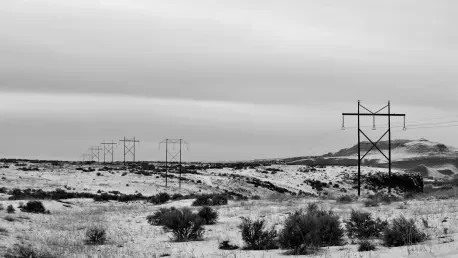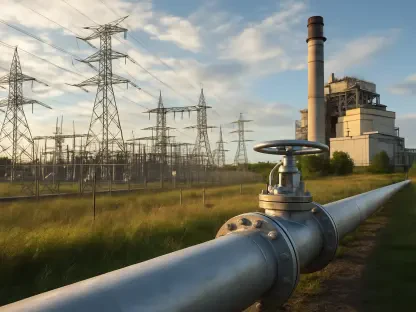As winter approaches in 2025, the North American electric grid faces an unprecedented challenge with peak demand projected to surge by 20 gigawatts (GW), a staggering 2.5% increase compared to last season, raising serious questions about the grid’s ability to keep pace. This rapid escalation, driven by expanding data centers and broader consumption trends, underscores the urgency of addressing energy security during the coldest months.
Rising Winter Demand: A Growing Challenge for Grid Reliability
The latest Winter Reliability Assessment from NERC underscores a troubling trend: winter peak demand is rising at a pace that outstrips the grid’s capacity to expand resources. This year’s forecast indicates a 20 GW spike in demand, with growth rates doubling over recent assessments. Such acceleration signals a shift in energy consumption patterns that the current infrastructure struggles to accommodate, particularly during high-stress winter periods.
Several structural issues contribute to this mismatch between supply and demand. Resource additions, critical for maintaining grid stability, have not kept up, increasing the risk of shortages during peak usage. This gap poses a fundamental question: how can the grid remain reliable under mounting pressure? Addressing this challenge requires not only immediate operational adjustments but also long-term planning to align resource development with evolving needs.
Background and Importance of Winter Grid Reliability
The North American bulk power system, overseen by NERC, is tasked with ensuring reliable electricity across diverse regions, a mission growing more complex as consumption patterns evolve. NERC’s role in assessing grid reliability becomes vital during winter, when extreme weather can push the system to its limits. The organization’s evaluations provide a roadmap for identifying vulnerabilities and guiding strategic responses to safeguard energy delivery.
Driving this heightened demand are factors like rapid data center expansion in areas such as the U.S. West, Southeast, and Mid-Atlantic, alongside consistent increases across nearly all assessed regions. These developments reflect broader economic and technological shifts that amplify electricity needs. The convergence of these trends with seasonal challenges underscores the urgency of reinforcing the grid to handle both routine and extreme conditions.
The stakes of grid reliability extend far beyond technical concerns. Energy security directly impacts economic stability and public safety, especially during harsh winter weather when heating and essential services depend on uninterrupted power. Failure to address these vulnerabilities could lead to widespread disruptions, highlighting the critical need for proactive measures to protect communities and industries reliant on a stable power supply.
Research Methodology, Findings, and Implications
Methodology
NERC’s approach to the current Winter Reliability Assessment involves a comprehensive analysis of data gathered from regional grids across North America. This process includes forecasting peak demand, evaluating resource adequacy, and simulating extreme weather scenarios to test system resilience. By integrating these elements, the assessment paints a detailed picture of potential stress points during the winter season.
Advanced tools play a key role in this evaluation, enabling precise calculations of reserve margins and regional risk profiles. Special attention is given to the integration of variable resources like solar and wind, which present unique challenges due to their intermittent nature. This methodological rigor ensures that the findings account for both expected conditions and unexpected disruptions that could threaten reliability.
Findings
The assessment reveals a stark imbalance: while winter peak demand is set to rise by 20 GW, total resource growth amounts to just 9.4 GW since last season. This shortfall is evident across various resource types, with solar contributing only 1 GW of effective capacity despite an 11 GW increase in installations, due to limited availability during peak winter hours. Thermal and hydro additions are modest at 3 GW, while wind capacity has dropped by 14 GW due to revised accounting practices in certain markets.
Regional vulnerabilities further compound these concerns. Areas like the Maritimes may depend on imports to meet peak needs, while New England faces risks of gas shortages during prolonged cold spells. The Southeast could encounter reserve shortfalls during early morning high-demand periods, ERCOT remains exposed to supply issues in extreme cold, and the Northwest struggles with resource adequacy during widespread frigid weather impacting thermal and wind outputs. These insights highlight uneven preparedness across the grid.
Implications
The practical consequences of these findings are significant, particularly during severe cold snaps when reliability risks escalate. Reserve shortfalls in key regions could lead to operational challenges, potentially disrupting power supply at critical times. This situation demands immediate attention to bolster resources and enhance system flexibility to withstand unexpected demand spikes.
Beyond technical issues, societal impacts are a pressing concern. Policymakers and industry leaders must prioritize reforms to streamline resource deployment, alongside market mechanisms that encourage private investment. Predictable rules and permitting changes are essential to accelerate capacity additions, ensuring the grid can meet future needs without compromising stability.
Operationally, managing a complex energy mix with growing reliance on variable resources adds another layer of difficulty. The interdependence with natural gas systems, crucial for winter power generation, requires close monitoring to prevent supply disruptions. These multifaceted challenges call for coordinated strategies to balance innovation with reliability in an evolving energy landscape.
Reflection and Future Directions
Reflection
Evaluating winter reliability brings to light several hurdles, including supply chain delays and policy barriers that slow resource growth. Integrating inverter-based resources like solar and wind into the grid remains a persistent challenge, often due to their variable output and the need for specialized infrastructure. These issues reflect deeper structural concerns rather than mere seasonal fluctuations, as noted by industry stakeholders.
The assessment process itself, while thorough, reveals gaps in understanding certain demand drivers, such as the precise impact of data center proliferation. Similarly, more granular analysis of weather patterns could refine risk predictions. Acknowledging these limitations helps frame the reliability challenge as a dynamic issue requiring continuous adaptation and deeper investigation.
Future Directions
Looking ahead, research should focus on enhancing demand forecasting, particularly for sectors like data centers that exhibit rapid growth. Exploring innovative grid technologies, such as advanced energy storage or grid-scale batteries, could offer solutions to balance variable resources during peak periods. These areas warrant dedicated study to develop scalable and effective responses.
Additionally, improving weatherization strategies for generation units is critical to mitigate risks during extreme cold. Developing robust monitoring systems for fuel supply, especially natural gas, can further strengthen winter preparedness. Investigating these operational enhancements will be key to reducing vulnerabilities and ensuring consistent power delivery.
Finally, policy reforms deserve closer examination, with a focus on streamlining permitting processes to expedite resource additions. Studies into market incentives that drive infrastructure investment could unlock new pathways for grid resilience. These research priorities aim to address both immediate risks and long-term structural needs, fostering a more reliable energy future.
Addressing Grid Strain for a Reliable Future
The recent Winter Reliability Assessment conducted by NERC paints a concerning picture of a grid under strain, with a 20 GW surge in peak demand far outpacing the 9.4 GW growth in resources. Regional vulnerabilities exposed during the analysis, alongside structural barriers like slow resource deployment, underscore the fragility of the system in the face of extreme winter conditions. The complexities of an evolving energy mix add further layers of difficulty to maintaining stability.
Moving forward, actionable steps emerge as critical to mitigating these risks. Accelerating policy reforms to streamline permitting and encourage private investment stands out as a priority, alongside operational enhancements like improved weatherization of generation units. Strengthening the interdependence between electric and gas systems through better fuel supply monitoring also proves essential. These measures, combined with targeted research into demand forecasting and grid technologies, offer a pathway to fortify the North American grid against future winter challenges, ensuring energy security for all.









